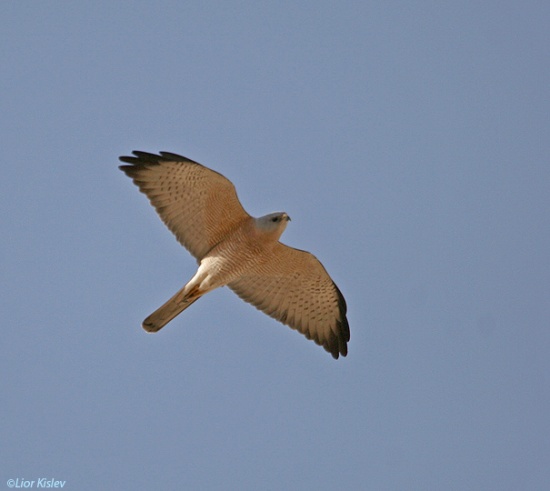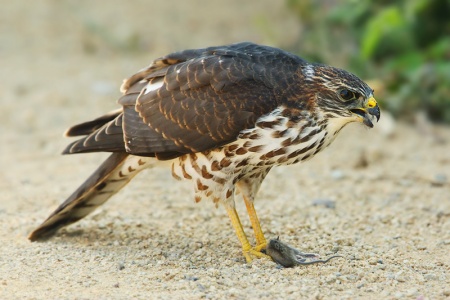(→Distribution: corrected link) |
|||
| (12 intermediate revisions by 5 users not shown) | |||
| Line 1: | Line 1: | ||
| − | ;Accipiter brevipes | + | ;[[:Category:Accipiter|Accipiter]] brevipes |
| − | [[Image:Levant_Sparrowhawk.jpg|thumb|550px|right|Photo by | + | [[Image:Levant_Sparrowhawk.jpg|thumb|550px|right|Photo by {{user|lior_kislev|lior kislev}} in Eylat, [[Israel]].]] |
==Identification== | ==Identification== | ||
| − | + | 30-37 cm. Female is larger than the male<br /> | |
| − | + | '''Male''' | |
| + | *Blue-grey upperparts | ||
| + | *Dark wingtips | ||
| + | *Barred reddish below<br /> | ||
| + | '''Female''' | ||
| + | *Slate-grey upperparts | ||
| + | *Darkish wingtips | ||
| + | *Barred reddish brown underparts | ||
| + | *Dark throat line<br /> | ||
| + | '''Juvenile''' | ||
| + | *Dark brown upperparts | ||
| + | *Darkish-streaked underparts | ||
| + | *Dark throat ([[Dictionary_G-L#G|gular]]) line | ||
| + | [[Image:Levant_Sparrowhawk_juvie_by_Momo.jpg|thumb|450px|right|Juvenile, notice the dark blotchy streaks on breast and the dark [[Dictionary_G-L#G|gular]] stripe on throat<br />Photo by {{user|Momo|Momo}} in Keramoti, [[Greece]], September 2008.]] | ||
| + | ====Similar Species==== | ||
| + | Levant Sparrowhawk usually shows four "fingers" which often produces an impression of pointed wings while [[Eurasian Sparrowhawk]] shows five-six "fingers". Levant Sparrowhawk therefore shows a flight silhouette that is surprisingly similar to [[Common Kestrel]]. Juvenile Levant differs in the more blotchy, streaked appearance of underside and a dark [[Dictionary_G-L#G|gular]] stripe, where juvenile Eurasian is barred below. | ||
| + | ==Distribution== | ||
| + | A summer visitor to the southern [[Ukraine]] and east across southern [[Russia]] to [[Kazakstan]] and in scattered parts of South-East [[Europe]]. There are small, isolated populations in southern [[Romania]] and [[Bulgaria]], the former [[Yugoslavia]], probably [[Albania]] and in particular, [[Greece]], and has bred in small numbers in south-east [[Hungary]]. In addition, breeds in western and northern [[Turkey]] and the Caucasus. | ||
| − | + | Winters in East [[Africa]] and seen on passage across Turkey, the [[Middle East]] and [[Egypt]]. The Bosphorus is the preferred migration route with smaller numbers through the Caucasus and the passage period is mid August-early October, peaking in the second half of September. The return movement takes place in mid-late April. Passage is very concentrated and most of the population move through in a few days in dense flocks. | |
| − | |||
| − | |||
| − | |||
| − | + | Vagrants recorded in [[Poland]], [[Cyprus]], [[Italy]] and [[Tunisia]] and a rare [[Dictionary_P-S#P|passage migrant]] to [[Kuwait]]. | |
| − | |||
| − | |||
| − | |||
| − | |||
| − | |||
| − | |||
==Taxonomy== | ==Taxonomy== | ||
| + | This is a [[Dictionary_M-O#M|monotypic]] species<sup>[[#References|1]]</sup>. | ||
==Habitat== | ==Habitat== | ||
| − | Deciduous woodland, in dry, hilly or lowland areas, often along rivers. | + | Deciduous woodland, in dry, hilly or lowland areas, often along rivers. |
| − | |||
==Behaviour== | ==Behaviour== | ||
| − | + | ====Breeding==== | |
| − | + | It nests in trees, lined with green leaves. The clutch consists of 3-5 eggs. | |
| + | ====Diet==== | ||
| + | Diet includes small birds, insects and lizards. | ||
| + | ====Vocalisation==== | ||
The call is a sharp "kee-wick". | The call is a sharp "kee-wick". | ||
| − | + | ==References== | |
| + | #{{Ref-Clements6thAug11}}#Wikipedia | ||
| + | {{ref}} | ||
==External Links== | ==External Links== | ||
| − | + | Search the Gallery using the scientific name: | |
{{GSearch|Accipiter+brevipes}} | {{GSearch|Accipiter+brevipes}} | ||
| + | Search the Gallery using the common name: | ||
| + | {{GSearch|"Levant Sparrowhawk"}} | ||
| + | {{GS-checked}} | ||
| + | <br /> | ||
| + | <br /> | ||
| − | + | [[Category:Birds]] [[Category:Accipiter]] | |
| − | [[Category:Birds]] | ||
Latest revision as of 00:05, 8 September 2023
- Accipiter brevipes
Identification
30-37 cm. Female is larger than the male
Male
- Blue-grey upperparts
- Dark wingtips
- Barred reddish below
Female
- Slate-grey upperparts
- Darkish wingtips
- Barred reddish brown underparts
- Dark throat line
Juvenile
- Dark brown upperparts
- Darkish-streaked underparts
- Dark throat (gular) line
Similar Species
Levant Sparrowhawk usually shows four "fingers" which often produces an impression of pointed wings while Eurasian Sparrowhawk shows five-six "fingers". Levant Sparrowhawk therefore shows a flight silhouette that is surprisingly similar to Common Kestrel. Juvenile Levant differs in the more blotchy, streaked appearance of underside and a dark gular stripe, where juvenile Eurasian is barred below.
Distribution
A summer visitor to the southern Ukraine and east across southern Russia to Kazakstan and in scattered parts of South-East Europe. There are small, isolated populations in southern Romania and Bulgaria, the former Yugoslavia, probably Albania and in particular, Greece, and has bred in small numbers in south-east Hungary. In addition, breeds in western and northern Turkey and the Caucasus.
Winters in East Africa and seen on passage across Turkey, the Middle East and Egypt. The Bosphorus is the preferred migration route with smaller numbers through the Caucasus and the passage period is mid August-early October, peaking in the second half of September. The return movement takes place in mid-late April. Passage is very concentrated and most of the population move through in a few days in dense flocks.
Vagrants recorded in Poland, Cyprus, Italy and Tunisia and a rare passage migrant to Kuwait.
Taxonomy
Habitat
Deciduous woodland, in dry, hilly or lowland areas, often along rivers.
Behaviour
Breeding
It nests in trees, lined with green leaves. The clutch consists of 3-5 eggs.
Diet
Diet includes small birds, insects and lizards.
Vocalisation
The call is a sharp "kee-wick".
References
- Clements, JF. 2011. The Clements Checklist of Birds of the World. 6th ed., with updates to August 2011. Ithaca: Cornell Univ. Press. ISBN 978-0801445019. Spreadsheet available at http://www.birds.cornell.edu/clementschecklist/downloadable-clements-checklist
- Wikipedia
Recommended Citation
- BirdForum Opus contributors. (2024) Levant Sparrowhawk. In: BirdForum, the forum for wild birds and birding. Retrieved 12 May 2024 from https://www.birdforum.net/opus/Levant_Sparrowhawk
External Links
Search the Gallery using the scientific name:
Search the Gallery using the common name:
GSearch checked for 2020 platform.





